
Habitat for Humanity Founder Millard Fuller Issues a Challenge to Service Summary: “What are we doing for others?,” AIA President Marshall Purnell, FAIA, quoted Martin Luther King Jr. on May 15 at the opening session of the 2008 AIA Convention. “It’s a question our first speaker had to struggle with before he discovered his own path in life.” From humble beginnings, Millard Fuller made his first million by age 29. But his business success also spelled failings in his health and sense of integrity . . . his family suffered. [ Watch a video of the speech ] With a renewed commitment to serve others, Fuller founded Habitat for Humanity International in 1976. His leadership helped forge Habitat into a worldwide Christian housing ministry that has inspired literally hundreds of thousands from different faiths to roll up their sleeves and grab a hammer. For those accomplishments, the AIA bestowed the Whitney Young Jr. Award on Fuller in 1988. In 1996, in conferring the Presidential Medal of Freedom on Fuller, President Clinton called Habitat for Humanity “the most successful continuous community service project in the history of the United States.”
A herculean challenge begins with a smile This grand, herculean task, was tempered by Fuller’s easygoing, Southern wit, and he began the convention’s first day in Boston with a story of his own conversion to service of the less fortunate. Fuller grew up in a church-going family in a small town in eastern Alabama. Early on, he set himself on a challenging life’s path. “In my going to church, I learned the teaching of the Christian faith, which was that it’s difficult for the rich to get into the Kingdom,” he said. “But I was an ambitious young man, and I read the Scriptures very carefully, and it only said it was difficult for the rich to get into the Kingdom, and so I decided I was going to be a rich Christian.”
Fuller and his partner became journeyman capitalists, selling holly wreaths, door mats, tractor cushions, student directories, publishing cook books, and more. They did get rich. Near graduation, Fuller owned half a city block in Tuscaloosa, was making $50,000 dollars a year, and for these reasons was questioning the logic of leaving school at all. But he did graduate, and got married in his last year of law school, moving to the state capital of Montgomery. He had acres and acres of land, lavish houses, boats, and servants. “We were wadin’ in high cotton,” he said. But his wife mostly felt alone. Fuller was a workaholic, spending night after night at the office. The marriage nearly fell apart, and she left for New York City. His challenge to serve Later, Fuller found himself at Koinonia Farms, a progressive Christian farming community near Americus, Ga., where Habitat for Humanity would eventually take root. He had fallen under the spell of Clarence Jordan, a New Testament Greek scholar, preacher, and farmer. Jordan helped to crystallize Fuller’s raw impulse to serve the needy in the Christian tradition, discussing the teachings of Jesus Christ with him while they milked.
Taking care of the least Fuller said that architects’ responsibility to live up to this aspiration is still a work in progress. “The Bible says ‘to he or she to whom much is given, much is required,’” he said. “To you incredibly intelligent and talented and highly educated men and women, you have a huge responsibility. No city is so well off that it can afford to squander a part of the next generation, and when we don’t provide adequate shelter for families, we are consigning a large number of the next generation to prison, to a life of not living up to their potential.” Habitat to today In 2005, Fuller left Habitat for Humanity and formed the Fuller Center for Housing, with a very similar mission to his previous organization. But Fuller said he doesn’t see the two entities as competing. “We will be competition when there’s a shortage of need,” he said. “We’ll fight over the last house that needs to be built, but we’re far from that point.”
This type of repair or renovation might not garner the interest of an architect today, but Fuller said it should be regarded as an opportunity to bring the dignity and worth of the profession to the people who need it most. “I have discovered that architects find it difficult to build for the poor,” he said. “Architecture schools don’t train you to build modest houses, but we need to change that. We need to reach out.”
| ||
Copyright 2008 The American Institute of Architects. All rights reserved. Home Page |
||
news headlines
practice
business
design
recent related
› Keynoter David Suzuki Issues “The Nature Challenge”
› Green is the Word: AIA Kicks Off National Convention
› Gore to AIA: Architects Needed More than Ever
Visit Habitat for Humanity International’s Web site.
Visit The Fuller Center for Housing’s Web site.
Photos by Aaron Johnson
Innov8iv Design
idistudio.com

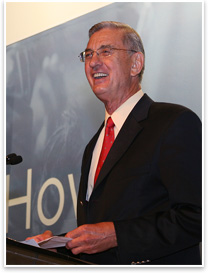
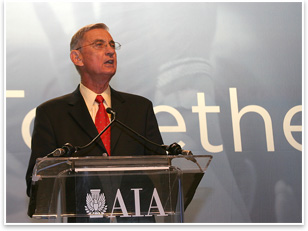 Quoting from the Gospel of St. Matthew, Purnell introduced Fuller: “For I was hungry and you gave me food; I was thirsty and you gave me something to drink; I was a stranger and you welcomed me; I was naked and you gave me clothing; I was sick and you took care of me; I was in prison and you visited me.”
Quoting from the Gospel of St. Matthew, Purnell introduced Fuller: “For I was hungry and you gave me food; I was thirsty and you gave me something to drink; I was a stranger and you welcomed me; I was naked and you gave me clothing; I was sick and you took care of me; I was in prison and you visited me.”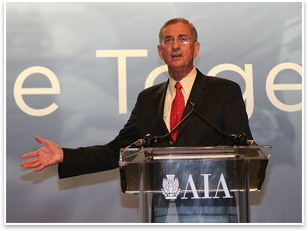 After attending Auburn University, Fuller went to law school at the University of Alabama and met a business partner with similar intent. The night they met, they decided they would form a law practice and a business, complete with a succinct mission statement: “To get rich.”
After attending Auburn University, Fuller went to law school at the University of Alabama and met a business partner with similar intent. The night they met, they decided they would form a law practice and a business, complete with a succinct mission statement: “To get rich.” 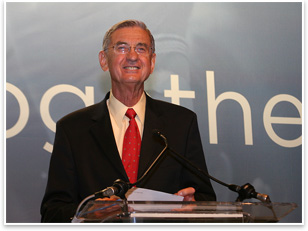 Fuller built his first house in 1969, applying the “Bible economics” of not charging poor clients interest for services and materials. It was a humbly organized operation as well. Fuller worked as surveyor, builder, and furniture mover. His law degree was put to use to draw up the closing transactions.
Fuller built his first house in 1969, applying the “Bible economics” of not charging poor clients interest for services and materials. It was a humbly organized operation as well. Fuller worked as surveyor, builder, and furniture mover. His law degree was put to use to draw up the closing transactions.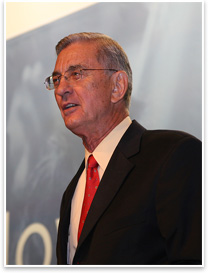 Fuller said that his Center for Housing (which has worked in 37 towns and states and 10 different countries in the three years since its founding) emphasizes green building practices like low energy costs and upkeep. It’s also sought to meet the needs of the nation’s changing and aging demographics by offering home repairs for needy senior citizens that allow the recipient to set their own payback schedule, no matter how modest.
Fuller said that his Center for Housing (which has worked in 37 towns and states and 10 different countries in the three years since its founding) emphasizes green building practices like low energy costs and upkeep. It’s also sought to meet the needs of the nation’s changing and aging demographics by offering home repairs for needy senior citizens that allow the recipient to set their own payback schedule, no matter how modest.